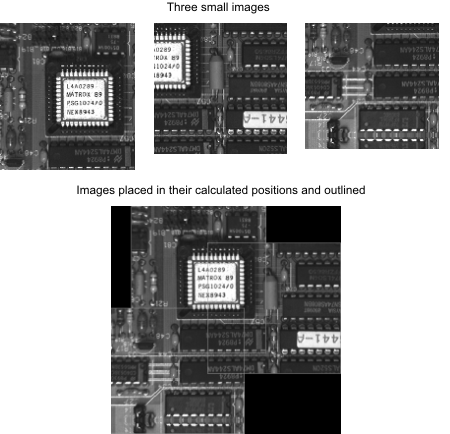MIL Registration module
The MIL registration module contains two different kinds of registration. The first is referred to as correlation registration, and can find the positional correlation between images in a common coordinate system. It can be used for mosaicing and super resolution. The second type, referred to as extended depth of field registration, or fusion, compares the focused objects in images of the same scene to produce one image combining all of the objects in focus.
Although the registration operation accepts color images, only band 0 is used. In contrast, color images are fully supported with the mosaicing operation. Each band must be 8-bit unsigned.
The Registration module does not take into account the calibration of images.
Correlation registration
The MIL Registration module allows you find the transformations that optimally position images in a common coordinate system; this is referred to as image registration, and the common coordinate system is referred to as the global pixel coordinate system. Registering images is necessary, for example, in industries that need to combine small images and analyze the larger one, recover the geometry of a scene, or superimpose and align two images to see the differences between them.

The module determines exactly how images overlap and fit together, based on the pixels in the images and some preliminary information that you supply. This information includes the rough location of all the images and the type of transformation to use to optimize their alignment. Using this information with advanced algorithms, the MIL Registration module finds the best match between the overlapping regions of the images. It then calculates the transformation that needs to be applied to each image to obtain the optimal match in the overlapping regions.
Mosaicing and super resolution
The Registration module supports mosaicing, which combines images to form one larger image or to create an image with improved resolution (super-resolution). It also supports converting coordinates between two of the following coordinate systems: the global pixel coordinate system, any image's pixel coordinate system, and the mosaic's coordinate system.
Using the mosaicing operation, the registration module physically combines the images used in a correlation registration, and can draw the outlines of how they fit together. This is often useful for taking images of small components that do not completely fit inside inside of a single image taken by your camera setup at a given resolution. This also allows you to take large objects in multiple images and add them together for a larger image combination. For more on mosaicing, see the Mosaicing section later in this chapter.
Super resolution is a process which combines images to enhance the resolution of an image. This is implemented by supplying the registration module will multiple images that are used to average out noise and produce a better quality image. Super resolution can be applied on camera setups to enhance the effective resolution of an imaging setup and produce images that can be scaled with less loss of information. You will need to first perform a correlation registration with high accuracy (call MregControl() with M_ACCURACY set to M_HIGH). For more information on super resolution, see the Mosaic composition using super-resolution subsection of the Mosaicing section later in this chapter.
Extended depth of field registration
A camera setup with a given depth of field does not always capture the all the information in focus. You can instead take multiple images of the scene at different focus distances to capture the entire field of view in focus, and perform an extended depth of field registration to create a single image with the objects in focus. This simulates a camera setup with an extended depth of field, and can be very useful for overcoming camera and lens limitations. Microscopy, for example, is one area where the possible depth of field is very shallow. The extended depth of field registration solves this kind of issue by combining multiple images taken with different focus distances to simulate an extended depth of field.
The extended depth of field registration, unlike the mosaicing and super resolution operations, does not use a previously performed correlation registration. The images in an extended depth of field registration overlap completely; they should be taken with exactly the same camera setup with different focus distances. For more extended depth of field registration, see the Extending your depth of field section later in this chapter.